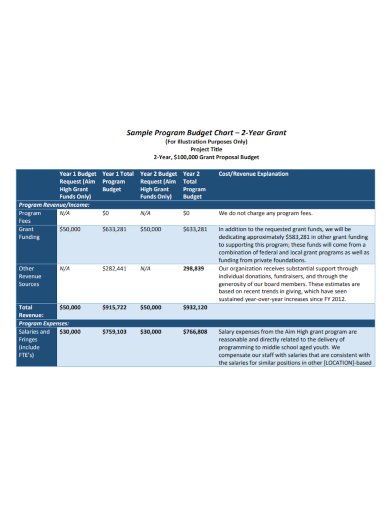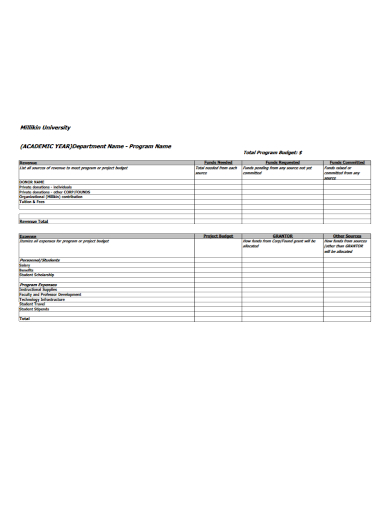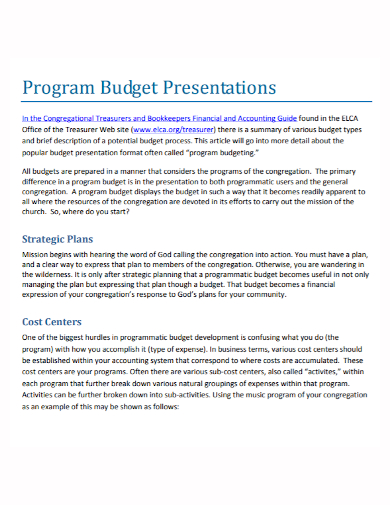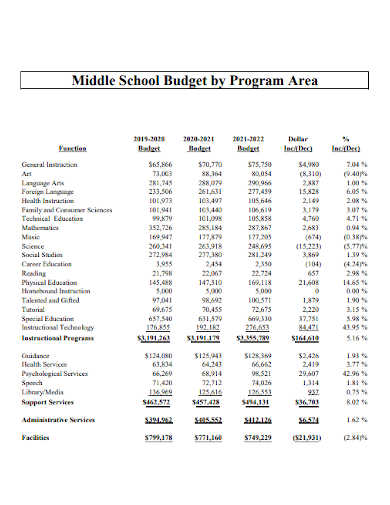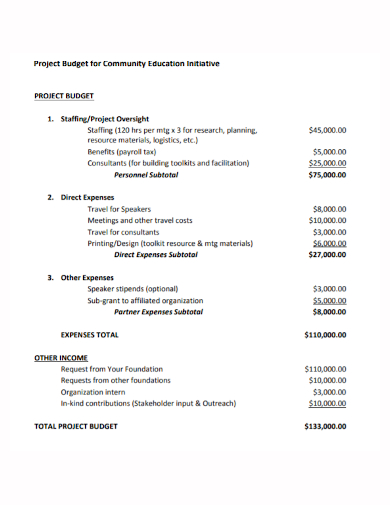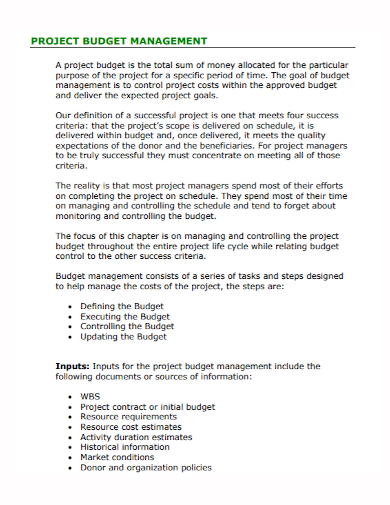Budgeting is a technique for planning an organization’s financial activity. Within the larger company, many organizations have departments or programs. Activities needing a budget may be carried out by any department or program. A budget is a record of all revenues and expenditures that aids a program in keeping track of the financial activities in which it participates. Within a school, for example, there are a variety of programs. Within a school with a program budget, a human resource committee is a regular program. The committee follows a set of objectives, and the funds spent within the budget must be in line with the committee’s and the organization’s overall objectives.
10+ Program Budget Samples
What is a program budget? A budget produced expressly for a project or program is known as a program budget. This budget comprises all costs and revenues associated with a single project. There are no other projects’ income or expenses mixed together with this one. Many separate projects are running at the same time in a business. As a result, it’s critical to establish the goals and objectives of each project, as well as its budget. The program budget allots money to a project, allowing for better monitoring of the project’s performance and increased accountability.
1. Program Budget Template
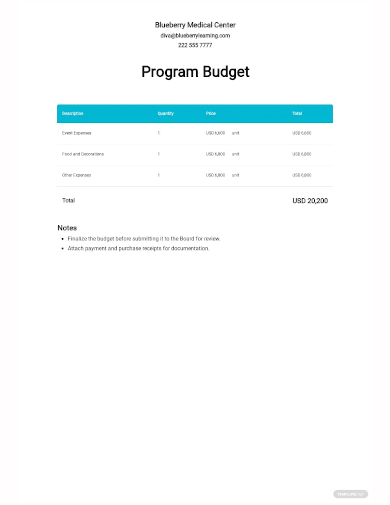
2. Program Budget Plan Template
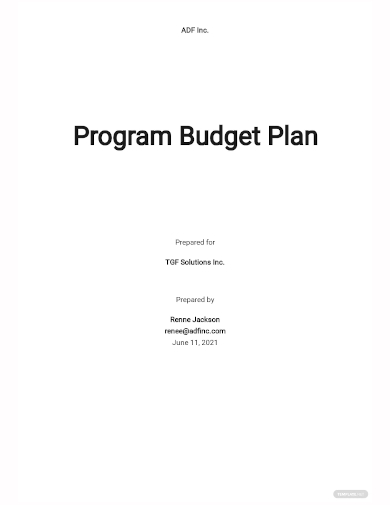
3. Nonprofit Program Budget Template
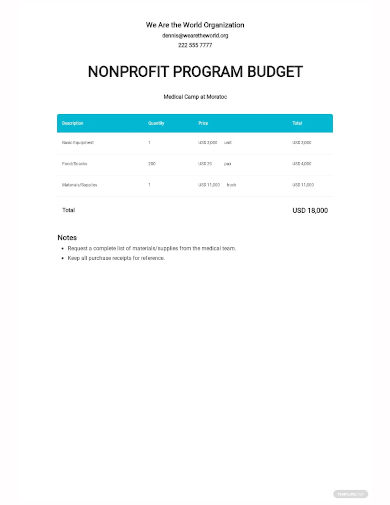
4. Nonprofit Program Budget Chart
5. Academic Program Budget
6. Elementary School Educational Program Budget
7. Program Budget Presentation
8. Middle School Budget by Program Area
9. Community Program Budget
10. Project Budget Management
11. Nonprofit Annual Program Budget
Creating Program Budget
- Make a list of all the expenses – Making a list of all the expenses your organization will have to cover annually for the program to be effective is the first step in creating a program budget. At this point, don’t worry about categorizing anything or calculating charges; simply put down all of your spendings in one long list. Read through your program description and think about everything that will cost money or time to make sure you’ve covered everything. Consider the costs of staff time, mileage, vendor fees, table brochures, and business cards, tent rents, and so on if your employees will attend outreach events. If you haven’t already done so, consider all of the activities involved in planning and implementing the program. Write down all of the costs associated with each of those tasks as you think about them.
- Categorize the expenses – It’s time to categorize your spending once you’ve compiled a list.
- Determine the cost of each expense – It’s time to figure out how much each item costs now that you’ve discovered and sorted all of your expenses. Determine the percentage of time each individual will spend on the program to calculate salary costs. Then multiply each person’s income by the percentage. Checking prices on your local office store’s website or asking for quotations for larger products will help you figure out how much all of your supplies, equipment, and “other” expenses will cost. Once you’ve figured out all of the expenditures, simply add them up to get the final program cost. To obtain a sense of how costs are spread, tally up the total costs within each category.
- Start writing a short narrative for each of the costs and expenses – You’ll have to discuss your program budget with others at some point, whether it’s your board of directors, other staff members, or possible sponsors. As a result, it’s critical that you give succinct descriptions of each item in your program budget. The importance of the spending to the program, as well as the calculations you used to establish the cost, should be the focus of these details.
- Consider revenue sources – It’s time to think about your revenue streams now that you know how much your program will cost. Make a list of all the current revenue you have that could fund this program, just like you did with the expenses. First, consider all of your current revenue streams. Then figure out how you’ll get the rest of the money. Write down the amount that will be supplied and the status of each source. Create a table containing each source’s quantity and status, and you’ll have a complete program budget.
FAQs
What is the responsibility of every committee that handles the program budget?
Programs or groups with a budget are in charge of keeping it up to date. This includes looking for new ways to make money. The program is also in charge of ensuring that the money is spent wisely to benefit the organization.
What is program-based budgeting?
Program-based budgeting is a budgeting framework in which funds are allocated to programs or functional areas depending on the nature of the programs’ activity. Program budgeting is used by many state and local governments, but it is also used by enterprises. Its goal is to make sure that spending is in line with program goals.
You now have a budget for your program. This is a useful tool for determining whether you can afford to provide another program. You can use your program budget in grant applications as well; just make sure it matches your program description and the formatting criteria of the funder.
Related Posts
FREE 10+ Expense Budget Samples in MS Word | Google Docs | Google Sheets | MS Excel | PDF
FREE 4+ Vacation Budget Planner Samples in PDF
FREE 10+ Budget Outline Samples in PDF | MS Word
FREE 10+ Conference Budget Samples in MS Word | MS Excel | Google Docs | Google Sheets | Apple Pages | PDF
FREE 10+ Monthly Budget Worksheet Samples in PDF | MS Word | Google Docs | Google Sheets | Excel
FREE 10+ Monthly Project Budget Samples in MS Word | MS Excel | Google Docs | Google Sheets | PDF
FREE 10+ Corporate Budget Samples in MS Word | MS Excel | Google Docs | Google Sheets | PDF
FREE 9+ Primary School Budget Samples in MS Word | Google Docs | Google Sheets | MS Excel | PDF
FREE 10+ Operational Budget Samples in PDF | DOC
FREE 5+ Budget Layout Samples in PDF
FREE 6+ Paycheck Budget Samples in PDF | MS Word
FREE 10+ Architecture Budget Samples in PDF
FREE 10+ Capital Budget Samples in PDF | MS Word | Google Docs | Google Sheets | Excel | Apple Numbers | Apple Pages
FREE 10+ Budget Tracker Samples in PDF | DOC
FREE 4+ Corporate Monthly Budget Samples in MS Word | Google Docs | Google Sheets | Excel

